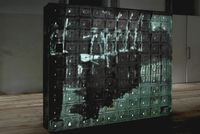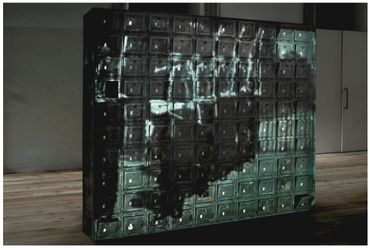![Cinema all'aperto [Outdoor cinema] by Fabio Mauri contemporary artwork works on paper](https://files.ocula.com/anzax/9e/9e09ffc4-ec37-43bc-87dc-582c8e99ccc8_200_146.jpg)
![Filmano tutto [They film everything] by Fabio Mauri contemporary artwork painting](https://files.ocula.com/anzax/4d/4d7832e3-6c77-4475-83c9-c63b97e476bc_200_200.jpg)
![Pittura [Painting] by Fabio Mauri contemporary artwork sculpture, moving image](https://files.ocula.com/anzax/e9/e93600cf-ff2d-4e29-8b8b-58f6243f2877_200_294.jpg)

Richard Saltoun Gallery is delighted to announce the first exhibition of the artist Fabio Mauri (1926–2009) at the gallery, curated by Laura Cherubini. The exhibition brings together works from the 1960s to the early 2000s, including film, found-object sculpture and installation, along the central theme of cinema.
Mainly concerned with the politics of visual culture and communications, Mauri's artistic practice is renownedly multifaceted, embracing performance, film, sculpture, installations, and mixed media works. His interests were widely disparate, including publishing, film, theatre, literature. The artist's youth was strongly marked by the events of the war and fascism, which had a profound impact on his artistic and intellectual legacy.
As director of the renowned Bompiani publishing house (of which his uncle, Valentino Bompiani, was the founder), he had a prominent role within Italian avant-garde circles, and was influenced by his friendships with important figures such as novelist Italo Calvino, philosopher and semiologist Umberto Eco, film director and enthusiast Pier Paolo Pasolini, and artist Jannis Kounellis.
The focal point of the exhibition is, Rebibbia (2006), a cabinet recovered from the Roman prison, belongs to the iconic Projections series. Started in the 1970s, the series consists of auteur films projected on unconventional historical media. The half-closed iron doors, on which Mauri projects "The Ballad of a Soldier," a film by Grigorji Chukhraj, symbolise a multiplicity of lives both lived and gone. The events of the war, linked to the place where this object was retrieved, not only document a historical event, but also narrate a reality in which various human events intertwine and merge. In the center of the gallery stands Pittura, a large film projector in which the canvas serves as a film, encapsulating the continuous dialogue between painting and cinema in Mauri's practice. Surrounding the space around it, the Schermi (Screens), made of unfolded canvas on frames and white cardboard serve as screen-drawing. Realised under the influence of Alberto Burri, these works celebrate the myth of cinema. The concept of the Screen emerged in early 1957 and remained essential to the articulation of Mauri's oeuvre. The black band painted on the edges is a clear tribute to cinema, but also refers to television, computers and technology. Through this, Mauri offers us, simultaneously, a critique and analysis on the experience of our reality.
Press release courtesy Richard Saltoun Gallery.
Via Margutta 48a-48b
Rome, 00187
Italy
https://www.richardsaltoun.com/
+39 06 86678 388
Tues - Sat, 10:30am - 7pm
